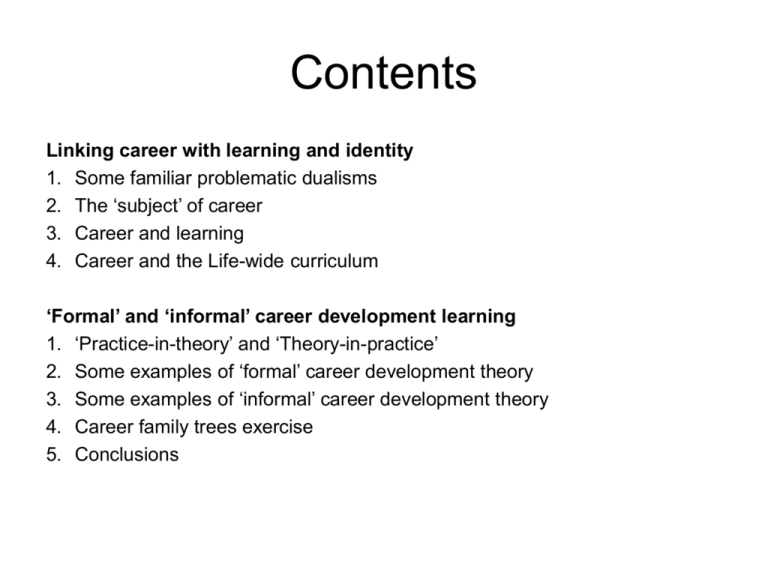career development learning - Learning to be professional
advertisement

Contents Linking career with learning and identity 1. Some familiar problematic dualisms 2. The ‘subject’ of career 3. Career and learning 4. Career and the Life-wide curriculum ‘Formal’ and ‘informal’ career development learning 1. ‘Practice-in-theory’ and ‘Theory-in-practice’ 2. Some examples of ‘formal’ career development theory 3. Some examples of ‘informal’ career development theory 4. Career family trees exercise 5. Conclusions Some familiar problematic dualisms • • • • • • Academic Ivory tower Education Theory Thought Study • Formal learning • • • • • • Real world University or school of life World of work Practice Action Life • Informal learning The ‘subject’ of career • There is an extensive literature on the subject of career drawing from the following fields: Education Psychology Organisations Sociology • Other disciplines have much to contribute: e.g. history, philosophy, professional learning. Career and learning • Jung (1954) • Lave and Wenger (1991) • Argyris and Schon (1974) • Mitchell and Krumboltz (1996) • Willis (1977) • Law (1996) • Kolb (1984) • Bowman, Hodkinson and Colley (2006) Career and the lifewide curriculum Practice-in-theory and Theory-in-practice • All our theories contain some practice. • Conversely, all our practices contain some theory (Argyris and Schon, 1974) • Let’s look at some ‘formal’ and ‘informal’ career development theories Four ‘formal’ career development theories Choice Developmental Four ‘formal’ career development theories (continued) Structural Chaos Examples of ‘informal’ career development theories • Self-observation generalisations (i.e. people’s beliefs about themselves) ‘I am good in maths but lousy in English’ ‘It’s hard for me to concentrate when I study’ ‘I must select a prestigious university’ • World-view generalisations (i.e. people’s beliefs about wider world) ‘To succeed in show business, you have to know the right people’ ‘Counselling is only for those who are naturally warm and intuitive’ ‘All doctors think they are God’ ‘Auto mechanics are out to rip you off’ ‘Peace Corps volunteers really care about people’ ‘All lawyers are sharks’ ‘Those who can, do; those who can’t teach; those who can’t teach, teach teachers’ • Drawn from Lynda Mitchell and John Krumboltz, 1996 (first statement 1979) 9 Career family trees exercise • Surfacing tacit or informal theories and beliefs s not always straightforward • Often involves thoughts and feelings • Privacy should be respected, and the following exercise is therefore purely voluntary. You will not be asked to disclose personal data This exercise is in two parts: 1. Fill in your career family tree as much as you can/wish 2. Reflect on this and the ideas we have looked at (life roles, types, inheritances (e.g. class, gender), development, choice, chaos etc.) Some relevant resources Inkson, K. (2007). Understanding Careers: the Metaphors of Working Lives. Thousand Oaks, CA: Sage. McCash, P. (2008). Career Studies Handbook: Career Development Learning in Practice. http://www.heacademy.ac.uk/resources/publications/learningandemployability (accessed 7 October 2008). Simon, R.I, Dippo, D., and Schenke, A. (1991). Learning Work: A Critical Pedagogy of Work Education. Bergin and Garvey: New York, NY. Tomlinson, M. (2007). Graduate employability and student attitudes and orientations to the labour market. Journal of Education and Work 20 (4): 285-304. Conclusions Knowing what we know now…. • The HE curriculum provides a space for the surfacing and refinement of thoughts and feelings about career • All staff connected with teaching this area need some familiarity with formal career development theories • All staff need to be able to recognise the tacit career development theories and beliefs of themselves and students; and be able to facilitate the ‘surfacing’ of these thoughts and feelings • The study of career is relevant to work-based learning, placement learning, vocational and professional courses, and workplace CPD • There are issues around professional identities References Argyris, C. and Schon, D. (1974). Theory in Practice: Increasing Professional Effectiveness. San Francisco, CA: JosseyBass. Bowman, H., Hodkinson, P. and Colley, H. (2006). Employability and Careers Progression for Full-time UK Masters Students. http://www.hecsu.ac.uk/hecsu.rd/research_reports_129.htm (accessed 15 October 2008). Inkson, K. (2007). Understanding Careers: the Metaphors of Working Lives. Thousand Oaks, CA: Sage. Jung, C. (1954). The Development of Personality. New York, NY: Princeton University Press/Bollingen Foundation. Pages 836. Kolb, D.A. (1984). Experiential Learning. Englewood Cliffs, NJ: Simon and Schuster. Lave, J. and Wenger, E. (1991). Situated Learning: Legitimate Peripheral Participation. Cambridge: Cambridge University Press. Law, B. (1996). A career-learning theory. In: A.G. Watts, B. Law, J. Killeen, J. Kidd and R. Hawthorn (eds.), Rethinking Careers Education and Guidance: Theory, Policy and Practice. London: Routledge. McCash, P. (2008). Career Studies Handbook: Career Development Learning in Practice. http://www.heacademy.ac.uk/resources/publications/learningandemployability (accessed 7 October 2008). Mitchell, L.K. and Krumboltz, J.D. (1996) Krumboltz’s Learning Theory of Career Choice and Development. In D. Brown, L. Brooks and associates, Career Choice and Development (third edition). Jossey-Bass: San Francisco, CA. Reinvention (The) Centre for Undergraduate Research. (2009). Students at Work: Learning to Labour in Higher Education. http://www2.warwick.ac.uk/fac/soc/sociology/rsw/undergrad/cetl/filmspublications/studentsatwork/ (accessed 9 March 2009). Simon, R.I, Dippo, D., and Schenke, A. (1991). Learning Work: A Critical Pedagogy of Work Education. Bergin and Garvey: New York, NY. Tomlinson, M. (2007). Graduate employability and student attitudes and orientations to the labour market. Journal of Education and Work 20 (4): 285-304. Willis, P. (1977). Learning to Labour: How Working-class Kids Get Working-class Jobs. Saxon House: Farnborough.




